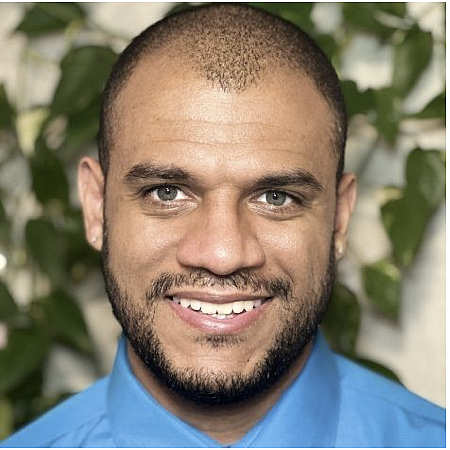The Health Divide: Study shows how biases in medicine increase cancer risks in LGBTQ+ community

The late Ronnie Grace, left, shown with the author.
(Photo by Damia Causey)
For decades, Ronnie Grace openly discussed being a Black gay man living with HIV. In the last few months of his life, he openly shared his cancer diagnosis.
As a program coordinator for HIV prevention and a peer navigator in Milwaukee, Grace was a spokesman and advocate for prevention efforts. He provided HIV testing and know-your-status assistance to thousands in southeastern Wisconsin, including distributing condoms, monitoring medication adherence, and facilitating access to medical providers for the initiation of pre-exposure prophylaxis (PrEP), a medication that can prevent HIV.
Grace, affectionately called “Unc” or “Uncle” by many of the young Black, gay, and trans men he mentored, passed away last fall from complications of Stage 4 liver and bile cancer at the age of 65.
His story fits a broader pattern of LGBTQ+ people disproportionately suffering from cancer and unequal treatment in health care systems across the country.
In May, a pioneering study led by researchers at Harvard revealed that individuals identifying as lesbian, gay, bisexual, and queer may face a heightened susceptibility to cancer compared to those identifying as heterosexual or cisgender.
Research confirms that LGBTQ+ people have a unique “cluster of risk factors” that would lead us to have both greater cancer incidence and later-stage diagnosis, the study says.
Among the factors contributing to disparities in LGBTQ+ cancer care are biases within the medical community, apprehension in seeking medical attention, and lifestyle choices such as smoking and drinking alcohol that elevate the risk of developing cancer, the study said. (The Center for Health Journalism recently hosted a webinar on LGBTQ+ disparities in health care.)
A 2023 survey revealed that 30% of medical students expressed discomfort in treating transgender patients.
Racial bias in pain assessment is a real issue in America
“We were already aware of the existing health disparities, albeit without the statistical evidence to support this knowledge,” said Chris Allen, chief executive officer of Diverse & Resilient, a nonprofit in Milwaukee that advocates for the health, safety, and well-being of the LGBTQ+ community.
Allen, who is African American, said the LGBTQ+ disparities in health care are even worse if you're Black or Latino due to the prejudice and bias in the medical community.
Grace, the HIV counselor, complained for months about having lower back pains before his symptoms were finally taken seriously by his physician, according to Allen.
Racial bias in pain assessment and treatment is a real issue in America, said Allen, who has over two decades of experience addressing health disparities within marginalized communities as an advocate.
Black individuals are consistently receiving inadequate pain treatment compared to their white counterparts, a disparity attributable to racial bias stemming from erroneous beliefs about biological distinctions between Black and white individuals.
There are many studies on these racial disparities, and unfortunately, they put a lot of people of color at risk of developing terminal illnesses, Allen said.
Since there are no biological or physiological differences between gay people and heterosexual people, cancer disparities trace their origin to a combination of socioeconomic factors and behaviors, many of which can be traced to the stress of living as a sexual or gender minority in the country, as the Harvard study suggests.
There are more than 1 million LGBTQ+ cancer survivors
The study shed light on several aspects of cancer within the LGBTQ+ community, but there is still much more to uncover.
Presently, most national cancer registries and surveys do not gather data about sexual orientation or gender identity. Consequently, LGBTQ+ cancer survivors remain underrepresented in the data, in contrast to demographic groups defined by ethnicity, geography, and race.
Having such data could facilitate the development of targeted prevention and treatment programs tailored to address the specific health disparities encountered by these communities.

Chris Allen, who leads the nonprofit Diverse & Resilient in Milwaukee.
Research has found that compared to heterosexual, cisgender people, LGBTQ individuals are more likely to be unemployed, uninsured, and lack access to health care. They also tend to delay essential health care, such as preventive care for cancer screening.
Allen, 37, said discrimination against gay people in health care has resulted in mistreatment and denial of care altogether.
At present, nine states have laws that allow medical professionals to refuse care to gay patients, affecting an estimated 20% of the LGBTQ+ population.
In the medical community, addressing LGBTQ+ health disparities will require providers to treat all individuals with dignity.
The American Medical Association offers some simple steps for providers to create an inclusive health care environment. These include prominently displaying brochures and educational materials about LGBTQ health concerns, posting a nondiscrimination statement visibly, and displaying posters from nonprofit LGBTQI+ or HIV/AIDS organizations.
The choice of language is significant, and understanding terminology is crucial for establishing trust within the LGBTQ+ community. However, health care providers must recognize that patients do not expect them to be infallible. Providers should acknowledge that they may not grasp every nuance or detail of their patients’ experience; nonetheless, they should demonstrate a commitment to continual improvement, as the AMA said.
Employing health care providers who advocate for LGBTQ+ initiatives can significantly improve trust within hospital and clinics. If a staff member does not support LGBTQ+ inclusive initiatives, physicians and practice managers should consider replacing them, the AMA said.
“Now that we know more about what the numbers show, what are we going to do about it?” Allen asked.

